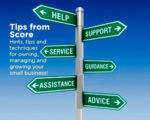Exhibitor Marketing
 Question: I am going to be exhibiting at a Home and Garden Show on the Cape in the spring. Any hot tips for more profitable exhibiting?
Question: I am going to be exhibiting at a Home and Garden Show on the Cape in the spring. Any hot tips for more profitable exhibiting?
Answer: from the pages of the CMO network, the following are hints, tips, and techniques for profitable exhibiting:
Guide your actions by the answers to these questions: (1) Why are you going to the show? (2) Who is your target audience? (3) When you engage a target, what do you want to communicate to them? 4) When the show is over, what is your measure of success?
Everyone involved in the outcome of the event, especially sales and marketing must be involved from the get-go. Marcomm may be responsible for the event, but they need to include the other functions to make it work for all involved.
The work of managing trade shows is not administrative; it is strategic.Trade shows must be looked upon as a venue for business opportunities. Most events fall short of their goals since there is no closed-loop lead management system.
Generating a return on your trade show investment starts with business objectives. Then you must create supporting strategies and tactics. If your objective is to lead for sales, then what are you going to do to generate leads (strategies) and how are you going to do it (tactics)?
What you use to attract, is who you will attract. Food attracts hungry people, not qualified prospects. Find the attraction that will draw your target audience, then create a plan around the attraction.
Be open to welcome and talk to everyone, but don’t get bogged down with someone who cannot help you meet your exhibiting objective(s). Determine what characteristics determine a qualified attendee and ask good questions before committing to spending any more than a few minutes with someone. Time is your competitor.
Go professional. If you show up with a table and wrinkled banner pinned to the drape, you don’t look like you are in business. Invest in a lightweight display with high-quality graphics. There are many sources of great graphics on the Cape.
Pre and post-event communication are critical to attracting the right visitors and to reinforcing the messages delivered at the show to the audience.
Divide and conquer, don’t sit with your teammates, eat with show attendees. You are there to network with customers and potential prospects. What better way than to “break bread” together.
Measure everything, the number of leads, the value of the leads, the number of people that stop to talk to you, sales generated from the show leads
Train your staff – prepare them to work the show by transitioning skills from the field to the show floor.
Always have a Plan B. Your original plan may not work out for any number of reasons. Seamlessly you need to move to Plan B.
If generating leads are your objective, determine who will be responsible for lead follow-up before you go to the show. If personal follow-up is required, bring a calendar and make an appointment while the attendee is at your exhibit.
Differentiate yourself. Make your exhibit, your staff and your presentation stand out so that visitors will take notice and remember you.
Promotional products can deliver higher quality returns than most forms of advertising. Industry research has found:
84% of respondents said that a branded promotional gift increases brand awareness 66% of respondents said they could remember the brand on a promotional product for at least a year.
87% said they kept a promotional product longer than 12 months
79% said they would likely do business with the company in the future
Effective giveaways are not a last minute decision. They need to be part of the overall plan. They are part of the promotions planning.
The first job of your exhibit is to attract attention. The second is to be the stage upon which your staff does their work in engaging, qualifing, communicating and closing on a commitment.











